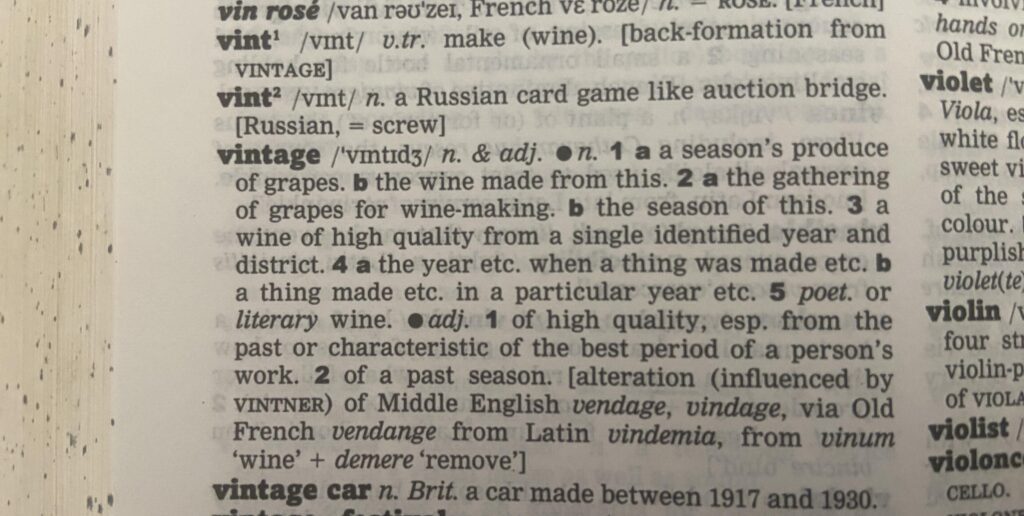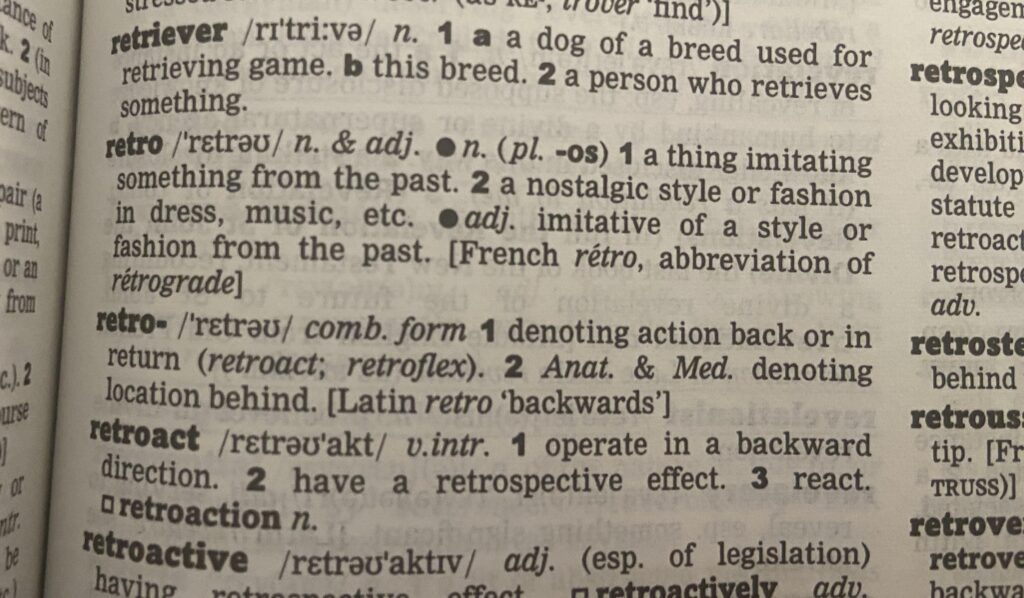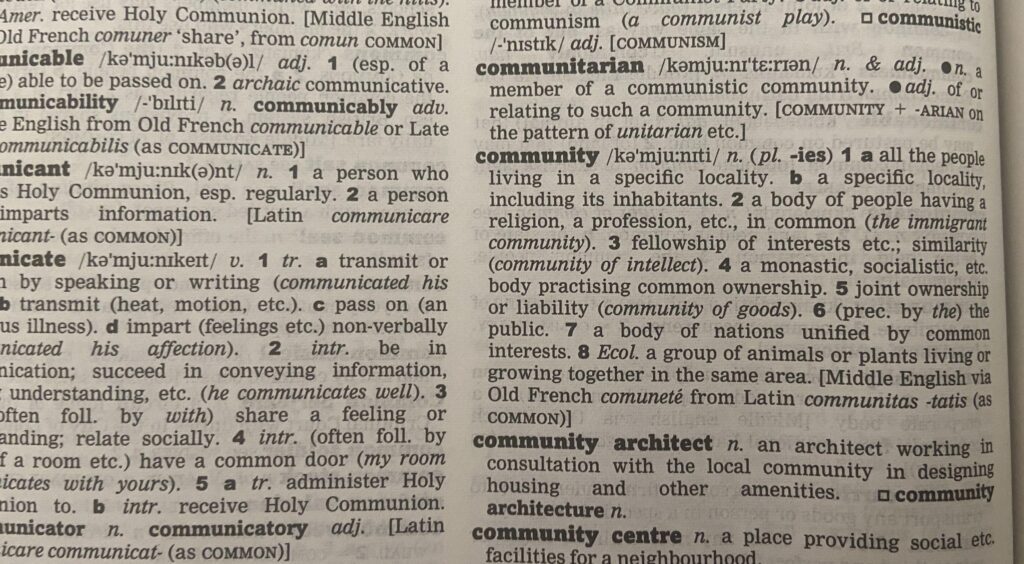Your One-Stop Shop for Mastering the Language of Our Marketplace

Welcome to the Vint Street Glossary.
Whether you’re browsing, buying, or selling, knowing your deadstock from your distressed denim, or your bids from your bundles, will give you a leg up on the competition and make your experience smoother (and way more fun).
The more seasoned pros among us might look down on some of the more obvious additions, bearing in mind that this is aimed at beginners, but there might still be a word or two in here that may be handy.
We cover loads, from vintage culture, clothing, to sales and platform terms, so you don’t get lost in all the jargon. We do like to keep that to a minimum but sometimes it can’t be helped.
Let’s get into it!
Vintage Fashion Terms
Deadstock
Brand-new, never worn or sold, vintage clothing or accessories that are often decades old but still in pristine condition. Deadstock items are rare gems for collectors and buyers who want the original, untouched look and feel.
Deadstock VS Vintage
Deadstock means brand-new old stock, vintage means used or worn but from a previous era. Deadstock tends to fetch higher prices due to rarity and condition.
Patina
The unique wear, aging, or discolouration on vintage items that adds character and evidence of age. Common in leather, metals, and fabrics. Patina is often prized by vintage lovers as it tells the story of the item’s life. It’s part of its charm.
Silhouette
The overall shape or outline of a garment, like A-line, hourglass, boxy, or tapered. Knowing silhouettes helps you understand fit and style without trying something on.
Distressed
Clothing that has been intentionally worn or aged to look vintage or broken-in. Distressed is a style choice, not a flaw, and is often desirable for denim and leather.
One-of-a-Kind (OOAK)
A unique item, either handmade or vintage, with no identical copies available.
OOAK pieces are prized for exclusivity.
Eras (Y2K, 90s, 70s, etc.)
Slang for clothing styles popular in particular decades or years. For example, “Y2K” refers to early 2000s fashion. Helps sellers and buyers target specific trends or nostalgia.
Pre-Loved
Another way of saying second-hand or vintage. Emphasises the sustainable, circular fashion angle. And that’s something we at Vint Street live by.
Fabric & Construction
Handwoven
Fabric made on a manual loom, often with visible textures and slight irregularities.
Adds artisanal value and uniqueness.
Bias Cut
Cutting fabric at a 45-degree angle to the grain, giving the garment stretch and a body-hugging fit. Often used in vintage slip dresses and bias-cut skirts.
Selvage Denim
Denim with finished edges that don’t unravel, woven on traditional shuttle looms. Highly sought after for durability and quality.

Platform Lingo & Selling Terms
Offer
A price a buyer proposes to pay for an item, which the seller can accept, decline, or negotiate. Encourages price flexibility and quicker sales.
Bid
Similar to an offer, but usually refers to placing a competitive price in an auction-style sale. Helps buyers compete for limited or hot items.
Relist
To put an item back up for sale after it has sold, expired, or been removed. Saves time for sellers who want to keep popular items available.
Bulk Upload
A tool allowing sellers to list multiple items at once instead of one by one. Essential for sellers managing large inventories.
Omnichannel
Selling listings appear across multiple channels — website, app, live sales, and social media — all at once. Increases exposure and sales potential.
Bundle
A group of items sold together, often at a discounted price. Encourages larger purchases and helps sellers move inventory faster.
Watchlist
A feature where buyers save items they’re interested in to track price changes or availability. Helps buyers keep tabs on their favourites.
Seller Profile
Your personal store or page on Vint Street, showing your items, bio, and ratings. Builds trust and brand for repeat sales.
Condition Grades
Mint
Like new, perfect condition, no visible signs of wear. Commands the highest prices.
Excellent
Light wear but no significant flaws. Buyers expect quality, but not necessarily pristine.
Good
Visible wear but no damage affecting use. Good balance between price and quality.
Fair
Noticeable flaws or repairs but still wearable or collectible. Appeals to those seeking character or on a budget.

Buying & Selling Tips
Deadstock vs. New Old Stock (NOS)
Sometimes used interchangeably but NOS usually refers to items held by retailers or manufacturers and never sold to customers. Deadstock can be NOS but also refers to old stock found elsewhere.
Flaws vs. Features
What one person calls a flaw (like a small stain or a missing button), another might call a feature or patina. Be honest about flaws when selling; it does wonders for building trust.
Authenticity
Proof or guarantee that an item is genuine, especially important for branded vintage goods. Look for original labels, stitching, and serial numbers.
Circular Fashion & Sustainability Terms
Upcycled
Vintage or second-hand items modified or combined to create a new product. Eco-friendly and creative.
Circular Fashion
A movement promoting reuse, repair, and recycling of clothing to reduce waste. Vint Street’s mission.
Now we’ve gone through the basics, here’s a glossary of wider terms you may come across on your hunt for your vintage treasures:
Additional Useful Vintage & Selling Terms
Vintage / Fashion Terms:
- Preppy — A style inspired by traditional American collegiate fashion.
- Fast Fashion — Cheaply and quickly produced clothing designed to be worn briefly, then discarded.
- Made in [Country] — Important for vintage authentication; e.g., “Made in Italy” often indicates luxury craftsmanship.
- Silk Screen Print — A printing technique used on fabric for graphic tees or vintage band shirts.
- Raglan Sleeve — A type of sleeve extending to the collar with a diagonal seam from underarm to neckline.
- Lining — The inner fabric layer in a garment, important for structure and comfort.
- Seam Allowance — The fabric between the edge and stitching line. Quite useful if planning alterations.
- Retro or Vintage Replica — New clothing designed to imitate vintage styles.
- Eco-Vintage — Vintage items sold with an emphasis on sustainability.
Fabric & Material Terms:
- Canvas — Heavy-duty woven fabric, often used in bags or shoes.
- Twill — Fabric with diagonal ribbing, common in denim or suits.
- Hemp — Natural fibre used in vintage clothing, eco-friendly and durable.
- Organic Cotton — Cotton grown without pesticides, often used in eco-conscious vintage collections.
- Nylon — Synthetic fibre, important to identify for care instructions.
- Wool Blend — Mix of wool and other fibres, affects warmth and feel.
- Linen — Lightweight, breathable fabric made from flax.
- Velvet — Soft, plush fabric with a distinct pile.
Condition & Care Terms:
- Moth Damage — Small holes caused by moth larvae, common in vintage woolens.
- Fading — Loss of colour intensity, often natural with age.
- Repairs — Visible mending or patching, which can add charm or affect value.
- Discolouration — Changes in colour, often from exposure to sunlight or chemicals.
- Shrinkage — Fabric shrinking after washing, important to note when selling.
- Pilling — Small fabric balls forming on the surface from wear.
Platform & Selling Terms:
- Reserve Price — Minimum price a seller will accept in an auction.
- Buy It Now (BIN) — Option for buyers to purchase immediately at a fixed price, bypassing bidding.
- Shipping Profile — Seller’s standard shipping rules (costs, methods, times).
- Condition Notes — Detailed description of item condition included in listing.
- Return Policy — Seller’s rules about accepting returns or exchanges.
- Invoice — Bill sent to buyer after purchase, sometimes including shipping.
- Stripe — A platform we use that manages online transactions
- Escrow — A third party holds the buyer’s payment until they receive and approve the item (not always used on every platform).
- Crosslisting — Listing the same item on multiple selling platforms.
- SKU (Stock Keeping Unit) — Unique identifier for inventory management.
- Authentication Service — Third-party verification of branded or luxury goods.
General Vintage Culture Terms:
- Thrifting — Shopping second-hand, often at thrift stores or charity shops.
- Reworking — Altering vintage items to fit current trends or sizes.
- Slow Fashion — Movement promoting buying less but higher quality and longer-lasting clothing.
- Capsule Wardrobe — A small collection of timeless pieces, often including vintage items.
- Heritage Brand — Brands with a long history, often producing vintage-style clothing (e.g., Levi’s, Barbour).

Putting These Terms To Good Use on Vint Street
Now you’re a pro when it comes to vintage lingo, here’s how you can use it to sound really clever when it comes to buying or selling, and interacting with the rest of our community:
- When listing, add relevant hashtags (#deadstock, #vintage90s, #upcycled) to improve discoverability.
- Use offer and bundle features to attract buyers.
- Keep your profile clear and friendly to build community trust.
- Engage in the Vint Street community by using terms properly — it signals you know your stuff!
And that about wraps things up!
If you found this helpful, or if there’s a term on here you see that we’ve missed and should add, do get in touch.
For any other help you may need on Vint Street, head over to our Help Centre, or keep digging through the other helpful articles on Word on the Street.
And if you haven’t already, check us out on Whatnot. We’re live every Tuesday!
Happy selling, thrifting, and style hunting!





Add comment